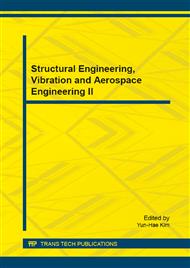p.180
p.185
p.192
p.197
p.205
p.213
p.218
p.222
p.230
Acceleration Data Acquisition and Analysis Method of Shaking Table Test
Abstract:
Shaking table test is an important means of simulated earthquake in laboratory, slope shaking table test data provide a scientific basis for analysis of dynamic stability and instability mechanism of slopes. Sine vibration table test data processing is different from general frequency domain analysis method, need real-time data processing in time domain. Taking the sine sweep test conditions, which is one of the conditions in "Earthquake landslide and slope prevention and control technology research on shaking table test", as an example. Describes the layout of sensors in shaking table test and the reasons; Sine sweep test load and aim; and listed the steps and methods of the sine sweep test in data processing; Through the processing and analysis of test data identified the vibration frequency of model and shaking table system is 30Hz, damping ratio is 2.06%; Analysis and calculation of the different sections of the slope and position of the amplification coefficient. A methodological guidance for shaking table test and dynamic response analysis of the slope is provided.
Info:
Periodical:
Pages:
205-212
Citation:
Online since:
January 2015
Authors:
Price:
Сopyright:
© 2015 Trans Tech Publications Ltd. All Rights Reserved
Share:
Citation:


